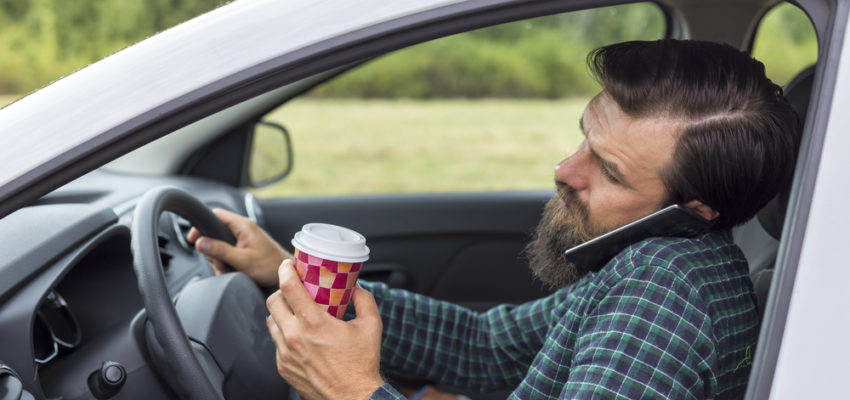Distracted Driving Awareness Month Is the Perfect Time to Take a Closer Look at Your Driving Behaviors

We know you’re probably doing your best to stay focused on reading this article. But we’re guessing the constant dings and alerts from your cell phone, the sound of your kids arguing in the background, or even the hunger pain growls coming from your stomach are all fighting us for your attention. We get it—this is the “Era of Unlimited Distraction,” after all. When your concentration gets constantly broken and you have to start something, like reading this blog post, over and over again, it can definitely be annoying. However, there is nothing inherently life-threatening about being this distracted all the time—unless, of course, you happen to be driving a car.
With April being Distracted Driving Awareness Month, the Bearingstar team wanted to take the opportunity to talk about the ongoing dangers of driving while distracted. According to the National Highway Traffic Safety Administration, this behavior continues to be a chief cause of vehicular accidents and loss of life on roadways across the United States. In this blog post, we share some important facts about distracted driving that might surprise you, as well as a few tips that may help all the drivers in your household limit distractions when they are behind the wheel. We hope you agree that this information is worth a few minutes of undivided attention.
What Are the Most Common Distracted Driving Activities?
Many people think that most distracted driving crashes today must be related to drivers using their electronic devices while operating a vehicle. Actually, there are numerous in-car activities that can lead a driver to take their eyes off the road, hands off the wheel, or mind off their driving, potentially leading to a serious accident.
Of course, talking, texting, and taking a selfie on a mobile device while you are behind the wheel are some of the most common examples of behaviors that result in distracted driving, but others include:
- Eating or drinking.
- Chatting with or showing affection toward a passenger.
- Adjusting a stereo or navigation system.
- Applying makeup, brushing your hair, flossing your teeth, or other forms of sprucing up.
These are everyday things that many people do while behind the wheel without considering the dangers. However, participating in these and similar activities often means you are taking at least one of your hands off the wheel and your attention off the road, sometimes for as long as five seconds or more. This may not sound like much time at all, but when you’re going 55 mph, it’s the equivalent of driving the length of an entire football field with your eyes closed.
In addition, if you’re driving distracted, your reaction time to things happening on the road around you is typically going to be delayed. If a car suddenly brakes in front of you or unexpectedly crosses into your lane, for example, it’s far less likely you will be able to make a decisive and safe move to avoid the other vehicle and an accident.
Do You Know the Distracted Driving Laws in Your State?
While there are many things that may lead a driver to take their eyes and mind off the road, it probably goes without saying that using a mobile device to take a phone call, text someone, or search for information is one of the riskiest forms of distracted driving.
For this reason, many states, including Massachusetts and Connecticut, have enacted hands-free laws that limit telephone use while behind the wheel. These driving laws generally prohibit all drivers, except emergency personnel performing official duties, from using handheld cell phones. From state to state, though, the details of the hands-free law—and the penalties for not following it—may vary slightly.
Massachusetts’s hands-free driving law prohibits operators of motor vehicles from using any electronic device unless it is used in hands-free mode. However, when driving in the Bay State, you are allowed to tap your device once to activate voice communication as well as to use a navigational touch screen if it’s mounted on your windshield or dashboard. It’s essential for parents to know that it is illegal for 16- or 17-year-old drivers to use any electronic devices while operating a vehicle in this state, even if these devices are in hands-free mode. The only exception to these rules is if a driver needs to use their cell phone to call 911 to report an emergency. Even in this situation, if possible, the driver should pull over and come to a complete stop before making the call.
If caught violating the hands-free law in Massachusetts, first offenders are subject to a $100 fine. Repeat offenders can face up to $500 in fines, may get hit with a car insurance surcharge, and are typically required to complete a distracted driving educational program.
The details of the Connecticut hands-free driving law include everything in the Massachusetts law and, in addition, specify that the law applies to any activity that a driver engages in that interferes with safe operation of the vehicle. This means that someone driving in Connecticut can be pulled over and ticketed for those seemingly innocent, but potentially harmful, activities we mentioned earlier in this blog post, like putting on makeup, eating, or participating in any other activity that distracts them from driving in a safe manner.
The penalties for offenders of the Connecticut hands-free law differ slightly too. A first-time offender is subject to a $150 fine, while repeat offenders can be fined up to $500. Distracted driving convictions in Connecticut may also lead to demerit points being added to a motorist’s driving record, and if a driver accumulates a certain number of demerit points, this can result in a suspended license. Depending on the circumstances, a distracted driving violation could also result in a reckless driving conviction. In a worst-case scenario, if a distracted driving offense results in the death of another person, it can lead to extremely serious charges against the at-fault driver.
3 Tips to Help You and Your Family Members Minimize Distracted Driving
With so much riding on your ability to stay focused on the road while driving, we wanted to provide you with some ideas on how to limit the chances you will get distracted.
#1 Organize everything before you start driving.
From downing a quick snack and taking a swig of water to adjusting your phone to play your favorite podcast and setting your navigation system to your destination, try to do as many of these types of activities before your travels get underway. Multitasking when you’re not driving can often be a time-saver, but trying to make calls, finish breakfast, or hit play on your favorite crime podcast while maneuvering a car on busy roadways is not safe or efficient—it’s just dangerous.
#2 Remove any temptations.
Even though it’s not illegal to talk on the phone if you’re using a hands-free device, it is still highly discouraged. That’s because while you’re catching up with an old friend, updating a colleague, or even asking Siri for information, you can easily miss important visual and audio cues needed to avoid a crash. The best practice is not only to put your mobile device away when you get in the car but also to silence it. Most cell phones have a driving mode option that can be turned on when you get behind the wheel. When this mode is activated, anyone who sends you a message will be notified that you are driving and will get back to them when you arrive at your destination. You can even set this mode up so that it turns on and off automatically based on whether it senses you’re in the car or not. As the saying goes, “out of sight, out of mind”!
#3 Let a passenger or AI navigate.
Why is it so hard for so many of us drivers to give up control of the directions? While it may be tough to hand over the role of navigation to a loved one or coworker who’s riding shotgun, it is truly the safest way for you and everyone in your car to get to an unfamiliar destination. If you’re alone driving to a new place, take a good long look at the directions prior to getting in the car and, before you take off, make sure to activate the AI voice on the navigation app that you’re using. Apps like Waze may help make your drive even safer by telling you the best route to take to avoid traffic jams or accidents and warning you of vehicles in the breakdown lane and other road hazards.
We’re Here for You With Additional Advice on Staying Safer on the Road and Beyond
At Bearingstar, we’re committed to providing information to all our customers, as well as the community at large, that helps them better protect their family, valuable belongings, and more. The last thing we ever want to happen is for you to have to make a car insurance or any other type of claim. So, we invite you to regularly check our blog posts and social media pages, including Facebook, Instagram, and LinkedIn, where we regularly share tips and insights on safeguarding the most important things in your life.
However, if you do have an accident, whether it’s due to distracted driving or another reason, our team will be here to support you with exceptional customer service. Our Massachusetts team can be reached by calling 877-801-7424, or you can talk to a Connecticut Bearingstar professional by calling 888-519-9996. Please call us whenever you need us.
Back to Blog